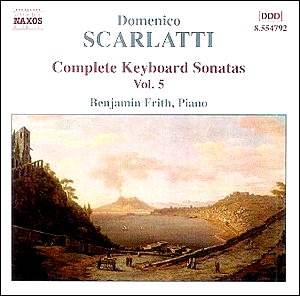Naxos
is making very slow progress with this series. The idea is potentially
a good one. Ask a variety of pianists, mainly young ones, to tackle
a recital of about seventy minutes’ duration of Scarlatti and
eventually record all 555 of them. Looking back, however, Volumes
1 and 2 were recorded in 1994/5 and this volume in 1999 so that
approximately 90 sonatas are now available. At this rate the later
volumes will be recorded by pianists who are not, at present,
even out of toddler stage.
The
other problem is that other companies are tackling the same project
and moving faster and more interestingly. Emilio Fadini has just
released his volume 5 and 6 for Stradivarius on the fortepiano.
This is proving an exciting and fascinating insight. Frederick
Haas on Calliope is using a warm sounding harpsichord for his
projected series. Of course there’s the harpsichordist Pierre
Hantaï on Auvidis who has made quite a ‘splash’. Luc Beauséjour
on the more obscure ‘Analekta Fleurs de lys label’ has quickly
moved to Volume 3. There is much competition. Do you want your
Scarlatti on the pianoforte? If you do why not go for the great
pianists?
One
essential is for the listener not to notice the performance, but
to let the music ‘be’. Many of the virtuosi of past generations
can be immediately excluded as they, rightly or wrongly, romanticize
the music, add ornaments, miss them out or avoid the repeats,
play too slowly or too fast. The young American pianist Michael
Lewin in Volume 2 of this series seems to me to fall at this hurdle.
But the good news is that Benjamin Frith, a pupil of Fanny Waterman,
already enjoying a distinguished career, does not. He allows the
music space, gives it shape and chooses tempi which seem to be
mostly ideal. He has the knack of making you forget that it is
a modern instrument you are hearing. I have to add that volumes
1, (Eteri Andjaparidze) 3 (Jeno Jando) and 4 (Beatrice Long) have
mostly eluded me so far but I hope that they are as impressive
as Frith.
Yet
again however I would like to put in a plea that we should be
told the edition being used for these recordings. Some things
don’t add up. For example there are some very odd accidentals
sounding at the beginning of the second half of the G major sonata
K494. Referring to the edition of the Sonatas by Eijo Hashimoto
for Schirmers I am struck by an additional bar, number 23 in fact,
played twice by Frith in the A major Sonata K113.
The
Sonatas in general follow a similar plan. Each is in binary form
with each half repeated. The second half either begins in or modulates
to a related key say the relative minor, sometimes moving into
a particularly distant key as in the G major Sonata K494. In the
case of the sonata in B minor K227 there is a remarkable contrast
of speed and time signature in the two halves, 2/4 and then 3/8.
Many are marked Allegro or Presto, having been written as keyboard
exercises for royal offspring or for Scarlatti to show off his
own abilities.
He
worked in either Portugal or Spain from c.1720 for the rest of
his life and almost all of the sonatas were written then and published
in Venice or London from c.1742. A few sonatas may well pre-date
1720 as for example the F major sonata K82 more chronologically
numbered by Giorgio Pestelli as P25. It is more noticeably a baroque
work reminiscent of his father. In fact this is one of the few
sonatas not in binary form, being one of the Essercizi marked
Toccata, i.e. brief - fast one movement structures of considerable
virtuosity. Another in a volume of Essercizi is the A major Sonata
K26 which goes in for much hand crossing. The Sonata in C minor
K37 (but P2) shows the influence of Vivaldi and may well have
been composed as early as 1715.
The
other sonata not in binary form is track 4 K284 in G major being
in Rondo form; unusual for Scarlatti. There is the usual imitation
of Spanish culture in several sonatas as in the G major sonata
K124 with a theme which had just been heard by the composer as
he wandered Madrid.
This
recording is very good and with the proviso that of the sixteen
sonatas perhaps too many (fourteen) are in a major mode, not offering
enough key contrast, this is a good volume to add to your Scarlatti
collection.
Gary
Higginson
see
also review by Kevin
Sutton
